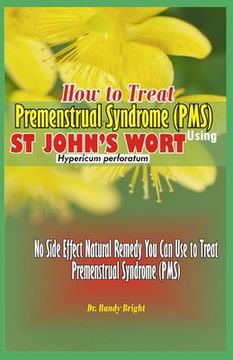How to Treat Premenstrual Syndrome (PMS): No Side Effect Natural Remedy you can use to Treat Premenstrual Syndrome (PMS) (en Inglés)
Reseña del libro "How to Treat Premenstrual Syndrome (PMS): No Side Effect Natural Remedy you can use to Treat Premenstrual Syndrome (PMS) (en Inglés)"
St. John's wort (SJW), known botanically as Hypericum perforatum, is a sprawling, leafy herb that grows in open, disturbed areas throughout much of the world's temperate regions. The use of this species as an herbal remedy to treat a variety of internal and external ailments dates back to the time of the ancient Greeks. Since then, it has remained a popular treatment for anxiety, depression, cuts, and burns. Recent research suggests the effectiveness of this herb in treating other ailments, including cancer, inflammation-related disorders, and bacterial and viral diseases, and as an antioxidant and neuroprotective agent. Pharmaceutical companies, particularly in Europe, prepare standard formulations of this herb that are taken by millions of people. Worldwide annual sales of products made from SJW presently exceed several billion dollars. Further, SJW produces dozens of biologically active substances, although two-hypericin (a naphthodianthrone) and hyperforin (a lipophilic phloroglucinol)-have the greatest medical activity. Other compounds, including the flavonoids rutin, quercetin, and kaempferol, also appear to have medical activity. H. perforatum has been intensively studied on isolated tissue samples, using animal models and through human clinical trials. The effectiveness of SJW as an antidepression agent is particularly well studied, and the underlying mechanisms are well understood. SJW preparations have relatively few adverse effects when taken alone at the recommended dosages. However, numerous interactions with other drugs have been reported. Recent research shows these interactions result from the ability of SJW constituents to induce intestinal or hepatic enzymes that either remove drugs from the body or metabolize them to inactive forms. This chapter examines the constituents, modes of action, and adverse interactions of SJW, providing an up-to-date synthesis of a large body of literature that has developed over the past 30 years regarding this widely taken herbal remedy. Some recommendations regarding future research needs are also presented.The SJW has been considered a medicinally valuable plant for over 2000 years. The Greek physicians of the first century, Galen, Dioscorides, Pliny, and Hippocrates, recommended SJW as a diuretic, wound-healing herb, treatment for menstrual disorders, and cure for intestinal worms and snakebites (Foster 2000; Castleman 2001; Redvers et al. 2001). Dried flowering tops placed in olive oil caused the oil to turn red after 3 weeks. The ancients believed the plant had mystical qualities, and plants were collected for protection from demons and to drive away evil spirits. In fact, the generic name Hypericum originated from the Greek name for the plant, hyperikon. Literally translated, the name is an amalgamation of the root words "hyper" (meaning over) and "eikon" (meaning image or apparition), referring to the plant's supposed ability to ward off evil spirits (Foster 2000). Early Christians also believed the plant had mystical properties. According to one legend, the greatest effect was obtained when the plant was harvested on Saint John's Day (June 24), which is often the time of peak blooming (Foster 2000). Another legend holds that the plant released its blood-red oil on August 29, the day of St. John's beheading (Castleman 2001).The plant enjoyed continued use as an herbal remedy in the Middle Ages. Sixteenth-century herbalists including Paracelsus, Gerard, and Culpeper all recommended SJW preparations to treat wounds and alleviate pain (Foster 2000; Castleman 2001). In 1525, Paracelsus recommended it for treating depression, melancholy, and overexcitation (Clement et al. 2006). The SJW's use as a medicinal herb continued in Europe, spreading to other continents, between the eighteenth and nineteenth centuries. It was commonly made into teas and tinctures for treatment of anxiety, depression, insomnia, water retention, and gastritis.

